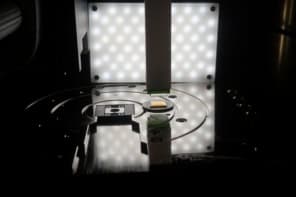Every physics student knows that a moving electron generates a magnetic field. But physicists recently discovered a completely distinct way in which electrons can create a field inside a magnet - by transferring some of their spin to the magnet. Now Wolfgang Weber of ETH Zürich and co-workers have measured the effect and believe it could be the key to ultra-high-speed recording in the ever-shrinking world of magnetic media (W Weber et al 2001 Science 291 1015).
When an energetic electron with a certain spin is injected into a ferromagnet – such as iron, cobalt or nickel – the spin on the electron partially aligns itself with the magnetic field. This means the magnet must be exerting a force on the spin. In turn, the electron exerts a force on the magnet to conserve angular momentum. The effect of a single electron on the magnetic field would be tiny, but Weber’s team found that a pulse of energetic electrons with identical spins packs a considerable punch.
The researchers injected electrons into a ferromagnet and checked their spins just femtoseconds – millionths of a billionth of a second – later. By measuring the degree to which the spins lined up with the direction of the magnetic field, they deduced how far the magnetic field vector moved – that is, an equal and opposite amount to the movement of the electron. In short, the electrons change the magnetization.
Weber’s team found that this so-called spin-transfer effect can produce an effective magnetic flux density as much as 1 tesla – ten times the value needed to switch the magnetization. The new technique also pinpoints the magnetic field to a very small area – the size of just a few atoms – which is an advantage in miniature devices. Existing devices rely on magnetic fields that decay slowly with distance – and this makes it hard to switch a single domain in a magnetic recording medium without disturbing its neighbours. The new method is particularly promising for high-speed recording because the pulse of electrons must be injected into the magnet in a tenth of a nanosecond, otherwise magnetic relaxation blocks the switching action.
The experimental system uses a beam of free electrons, but the next goal is to use electrons with lower energies in a more practical device. “Next, we aim to integrate the spin-polarized electron source, the ferromagnetic film and the spin analyser in a layered-film structure,” Weber told PhysicsWeb.
Physicists J C Slonczewski and L Berger independently discovered the ‘spin-transfer’ effect in 1996. Slonczewski’s patent – number 5695864 – on any future devices that exploit the effect is registered with the US Patent Office.



